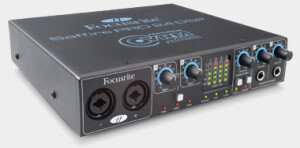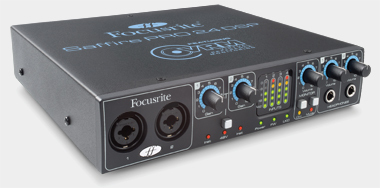View other reviews for this product:
« More honest ... »
Published on 12/23/10 at 14:13
Value For Money :
Excellent
Being moved from a Pentium 4 to a Quad Core Windows 7, my "old" map no longer MEDIA7.1 upgraded drivers for Seven. I did not break my piggy bank (it was already done for my new tower). I did a little tour of the market and proposed the name "Focusrite" and his fame have tipped the balance for the budget that I intended.
I was also questioned on the possibility to listen through the DSP presets plays different systems, so-called simulated by "modeling". And there, CATA: it's worth nothing!
My config consists of a Quad Core CPU i5 750@2.65 Ghz.
RAM 4gig DDR3
Operating System: Windows 7 64 bit
1.5 Terabit hard disk.
Usage: Home Studio noncommercial
I use the 2 pre-amp fronts for recording an electric guitar and / or acoustic and voice with a condenser microphone powered by 48 volts. 2 headphone outputs with their own volume knob (that's good).
The Soft TOTAL MIX Control "damn good (although a bit complicated at the base). But once treated, it does. Flexibility of listening. I have 2 audio systems easily switchable. 2 entries for each facial (those with pre-amp, so), can trigger a compressor and an EQ before recording. For those (or those) who have no compressor or equalizer of physical input, and it was interesting ... it works pretty good. Full routing capabilities. And if the Saffire does not support direct monitoring, there is a way through the DSP card to obtain a zero latency is not negligible (even if not quite true). Example: I get my electric guitar in Cubase and I choose an amp simulation. I turn back listening to the sound of the amp selected while I record and that's despite the "Zero Latency" everything depends on the buffers that you have chosen.
Automatic management of change of the clock. This means that when you go (in Cubase, for example) a piece to another 44.1Khz 96Khz, the clock will change by itself.
You can even send the reverb in the headphones of the singer for his comfort without saving it (reverb, eh ???).
UTILIZATION
The new drivers downloaded from manufacturer's works fine. No binz with Windows 7. VERY stable.
Used DAW: Cubase 5.
The music projects are still used beefy. It often revolves around 16 tracks to 20 with 4 to 5 plug in (sometimes heavy like Drumagog or another Amplitube 2 and 3), reverb, compressors, EQ, etc. ... or lots of MIDI tracks. But hey, there's very clearly the power of the PC that makes all the difference. To laugh, I tried it on my "old" pentium 4 to play a song and he would not even start: CPU Cubase in the red.
I've never tried to record several tracks simultaneously.
The latency (and hence the possibility of using very small buffer sizes) clearly depends on the number of tracks (with their plug in) you use.
GETTING STARTED
I have experienced no problem during installation. Do not install the drivers from the installation CD but get the latest drivers directly on the site Focusrite. On this site you can also activate the bundle of plug-in available for purchase on the card.
Not easy to navigate interface "Saffire Control Mix": true table mix / gas plant where a lot of routing options available to you.
The manual is downloadable in PDF format in French. I suggest you read it before use. After several manip not always included at the beginning, things back to normal and especially in the brain thereafter.
OVERALL OPINION
I use it for + / - 4 months now.
As said before, my old card started dating. Personally, I never acquired a professional audio interface type while in the band I played in our room we use a MOTU 24 I / O and also a MOTU Traveller. It is clear that the MOTU is MUCH more professional. Quality pre-amp., The DSP PCI card in the 24 I / O, etc..
What I like:
the quality of its pre-amp (given its price), the management of two completely separate headphone outputs. The solid feel of the case and its knobs. The interface of the table with its mix, relatively, big potential. To hear my mix on 2 different systems plays a single click from the software interface.
The existence of a compressor and an EQ pre-registration. Failing to TOP, it at least has the merit to exist.
Its price, more than correct.
What I hate:
On the "Pro 24 DSP, they simulated by convolution, different speakers and modeling, different parts of listening. All this, listening through headphones. Not terrible. I must confess that I had packed it (before buying) and I had badly disillusioned later. For me it's unusable. It does absolutely not what REAL speakers give. There is even, in my opinion, quite far off. One wonders how the modeled speaker brands do not pose a defamation suit.
In conclusion, I would say that for value for money (even more convincing without the famous speaker simulation, since it is a model without the DSP and is less expensive), one has for his money. In fact, it is quickly forgotten, which for me is good.
In hindsight, I would do this purchase (although the simulation model without speakers) if I had to stay on budget. But if next purchase, there is, I think of stuff to look more professional. What? Ahhh, that I know yet ...
I was also questioned on the possibility to listen through the DSP presets plays different systems, so-called simulated by "modeling". And there, CATA: it's worth nothing!
My config consists of a Quad Core CPU i5 750@2.65 Ghz.
RAM 4gig DDR3
Operating System: Windows 7 64 bit
1.5 Terabit hard disk.
Usage: Home Studio noncommercial
I use the 2 pre-amp fronts for recording an electric guitar and / or acoustic and voice with a condenser microphone powered by 48 volts. 2 headphone outputs with their own volume knob (that's good).
The Soft TOTAL MIX Control "damn good (although a bit complicated at the base). But once treated, it does. Flexibility of listening. I have 2 audio systems easily switchable. 2 entries for each facial (those with pre-amp, so), can trigger a compressor and an EQ before recording. For those (or those) who have no compressor or equalizer of physical input, and it was interesting ... it works pretty good. Full routing capabilities. And if the Saffire does not support direct monitoring, there is a way through the DSP card to obtain a zero latency is not negligible (even if not quite true). Example: I get my electric guitar in Cubase and I choose an amp simulation. I turn back listening to the sound of the amp selected while I record and that's despite the "Zero Latency" everything depends on the buffers that you have chosen.
Automatic management of change of the clock. This means that when you go (in Cubase, for example) a piece to another 44.1Khz 96Khz, the clock will change by itself.
You can even send the reverb in the headphones of the singer for his comfort without saving it (reverb, eh ???).
UTILIZATION
The new drivers downloaded from manufacturer's works fine. No binz with Windows 7. VERY stable.
Used DAW: Cubase 5.
The music projects are still used beefy. It often revolves around 16 tracks to 20 with 4 to 5 plug in (sometimes heavy like Drumagog or another Amplitube 2 and 3), reverb, compressors, EQ, etc. ... or lots of MIDI tracks. But hey, there's very clearly the power of the PC that makes all the difference. To laugh, I tried it on my "old" pentium 4 to play a song and he would not even start: CPU Cubase in the red.
I've never tried to record several tracks simultaneously.
The latency (and hence the possibility of using very small buffer sizes) clearly depends on the number of tracks (with their plug in) you use.
GETTING STARTED
I have experienced no problem during installation. Do not install the drivers from the installation CD but get the latest drivers directly on the site Focusrite. On this site you can also activate the bundle of plug-in available for purchase on the card.
Not easy to navigate interface "Saffire Control Mix": true table mix / gas plant where a lot of routing options available to you.
The manual is downloadable in PDF format in French. I suggest you read it before use. After several manip not always included at the beginning, things back to normal and especially in the brain thereafter.
OVERALL OPINION
I use it for + / - 4 months now.
As said before, my old card started dating. Personally, I never acquired a professional audio interface type while in the band I played in our room we use a MOTU 24 I / O and also a MOTU Traveller. It is clear that the MOTU is MUCH more professional. Quality pre-amp., The DSP PCI card in the 24 I / O, etc..
What I like:
the quality of its pre-amp (given its price), the management of two completely separate headphone outputs. The solid feel of the case and its knobs. The interface of the table with its mix, relatively, big potential. To hear my mix on 2 different systems plays a single click from the software interface.
The existence of a compressor and an EQ pre-registration. Failing to TOP, it at least has the merit to exist.
Its price, more than correct.
What I hate:
On the "Pro 24 DSP, they simulated by convolution, different speakers and modeling, different parts of listening. All this, listening through headphones. Not terrible. I must confess that I had packed it (before buying) and I had badly disillusioned later. For me it's unusable. It does absolutely not what REAL speakers give. There is even, in my opinion, quite far off. One wonders how the modeled speaker brands do not pose a defamation suit.
In conclusion, I would say that for value for money (even more convincing without the famous speaker simulation, since it is a model without the DSP and is less expensive), one has for his money. In fact, it is quickly forgotten, which for me is good.
In hindsight, I would do this purchase (although the simulation model without speakers) if I had to stay on budget. But if next purchase, there is, I think of stuff to look more professional. What? Ahhh, that I know yet ...




